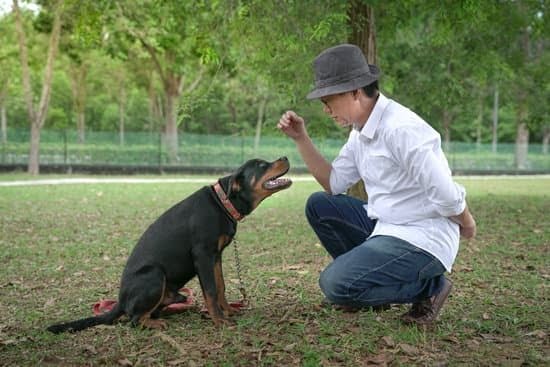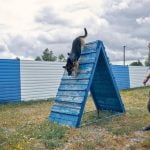Training your dog to defend you can provide an added layer of security and peace of mind in various situations. Whether it’s a potential intruder, a threatening stranger, or simply a dangerous situation, having a dog trained to protect you can be invaluable. In this article, we will explore the essential steps and techniques on how to train your dog to defend you effectively.
Dogs have natural instincts that make them excellent protectors. Their loyalty, sharp senses, and territorial nature can be honed through training to become reliable guardians. Understanding these innate qualities in your furry companion is crucial in developing their skills as defenders. By tapping into these instincts and guiding them with the right training methods, you can enhance your dog’s ability to keep you safe.
Building a strong bond with your dog is fundamental to successful protection training. Trust and communication are key components in creating a solid foundation for defense training. Through positive reinforcement, consistent guidance, and mutual respect, you can establish a connection built on trust and loyalty with your canine partner. This bond will not only strengthen your relationship but also enhance the effectiveness of your dog’s protective capabilities.
Understanding Your Dog’s Natural Instincts
Dogs are known for their loyalty, protectiveness, and natural instincts to guard their owners. Understanding these innate qualities in dogs can help in effectively training them to defend you when needed. One of the key reasons why dogs make great guardians is their strong sense of loyalty towards their owners. This loyalty drives them to protect and defend their human family members from any potential threats or danger.
In addition to loyalty, dogs have a keen sense of hearing and smell, making them highly alert to their surroundings. This heightened awareness allows them to detect potential dangers even before they occur. By tapping into these natural instincts, dog owners can further enhance their pet’s ability to act as a reliable guardian and protector.
To train a dog to defend you, it is crucial to establish a strong bond based on trust and communication. Building this foundation with your furry companion will not only strengthen your relationship but also ensure effective protection training.
Through positive reinforcement techniques and consistent practice, you can teach your dog how to recognize threats, respond appropriately, and stay by your side in times of need. With the right training tools and approach, you can empower your dog to become a reliable defender while maintaining control over its behavior.
| Key Points | Details |
|---|---|
| Loyalty | Dogs have a strong sense of loyalty towards their owners which drives them to protect and defend. |
| Alertness | Dogs have keen hearing and smell which makes them highly alert to potential dangers. |
| Bond Building | Establishing a strong bond based on trust and communication is essential for effective protection training. |
Building a Strong Bond With Your Dog
To strengthen the bond with your dog, consider the following tips:
- Spend quality time together: Engage in activities that your dog enjoys, such as playtime, walks, or training sessions.
- Use positive reinforcement: Reward good behavior with treats, praise, and affection to encourage a positive association with training.
- Establish clear communication: Learn to understand your dog’s body language and cues, while also teaching them basic commands for effective communication.
By nurturing a close relationship with your dog, you are laying the groundwork for successful protection training. This bond will not only strengthen your connection but also provide a sense of security knowing that your four-legged friend is by your side and ready to defend you when necessary.
Remember that forming a strong bond takes time and patience. Be consistent in your interactions with your dog and always approach training exercises with love and understanding. With dedication and effort, you can build a solid foundation for effective protection training and ensure that your dog is prepared to defend you when needed.
Basic Obedience Training
Training your dog to defend you can be a crucial skill in ensuring your safety and security. However, before diving into advanced protection techniques, it is essential to start with basic obedience training. This foundation will set the stage for more complex defense training down the line. Basic obedience training includes commands like sit, stay, come, and heel, which are essential for effective communication between you and your dog.
One of the first steps in basic obedience training is establishing yourself as the pack leader. Dogs are naturally pack animals and look to a leader for guidance. By taking on this role and setting rules and boundaries, you can gain your dog’s respect and trust. Consistency is key in obedience training, as dogs thrive on routine and structure. Reward-based training methods can be highly effective in reinforcing desired behaviors while discouraging unwanted ones.
As you progress through basic obedience training, focus on building a strong bond with your dog. This bond forms the basis of a solid relationship built on mutual trust and understanding. Remember that effective defense training requires a deep connection between you and your furry companion. By investing time in building this relationship early on, you’ll create a solid foundation for teaching your dog how to defend you in more advanced scenarios.
| Aspect | Detail |
|---|---|
| Training Method | Reward-based training methods |
| Key Command | Sit, stay, come, heel |
| Importance | Foundation for effective communication and future defense training |
Advanced Protection Training Techniques
When it comes to training your dog to defend you, advanced protection training techniques are essential in honing your dog’s skills and capabilities. These techniques go beyond basic obedience training and focus on strengthening your dog’s natural instincts as a guardian. Here are some advanced methods to consider when teaching your dog to defend you:
- Bite Work: This technique involves training your dog to bite on command and release on cue. It is crucial for your dog to understand when and how to use its bite effectively in a defensive situation.
- Guarding Skills: Teach your dog how to protect specific areas or objects by guarding them against potential threats. This can be useful in securing your home or property.
- Attack Commands: Train your dog to respond to specific attack commands, signaling when it should take action to defend you from harm.
It is important to remember that these advanced protection training techniques should only be undertaken with the guidance of a professional trainer experienced in defense training for dogs. Proper supervision and instruction will ensure that the training is conducted safely and effectively.
In addition, consistency and patience are key when implementing advanced protection training techniques with your dog. Regular practice, reinforcement, and positive reinforcement will help solidify these skills and behaviors over time. By investing time and effort into this type of training, you are equipping your dog with the tools necessary to effectively defend you in dangerous situations.
Teaching Your Dog to Recognize Threats
Understanding the Importance of Building Awareness
Building awareness in your dog is a crucial aspect of training them to defend you effectively. Dogs are naturally attuned to their environments and can pick up on cues that may signal potential threats. By harnessing this natural instinct and directing it towards recognizing specific threats, you can enhance your dog’s ability to protect you in various situations. Training your dog to be alert and aware of their surroundings can help prevent dangerous situations before they escalate.
Developing Alertness Through Training
One way to teach your dog to recognize threats is through specialized training exercises that focus on honing their alertness skills. Using tools like scent recognition, auditory cues, and visual stimulation, you can help your dog learn to differentiate between everyday sounds and behaviors versus potential dangers. Consistent practice and positive reinforcement are key components in reinforcing these skills and ensuring that your dog remains vigilant at all times.
Practical Techniques for Enhancing Awareness
To further enhance your dog’s ability to recognize threats, consider incorporating practical techniques into their training regimen. Engage in controlled role-playing scenarios where you act as the perceived threat, allowing your dog to practice responding appropriately.
Additionally, exposing your dog to different environments and stimuli can help sharpen their senses and improve their overall awareness levels. By consistently working on building awareness and alertness in your dog, you are empowering them with the skills needed to defend you effectively in any situation.
Handling Aggression
Aggression is a natural behavior in dogs that can be both beneficial and challenging when training them to defend you. It is important to understand that aggression does not equate to being out of control or violent.
In the context of protection training, controlled aggression means that your dog is able to effectively respond to a threat while still being under your command. This balance between protection and control is crucial in ensuring the safety of both you and your dog.
Channeling Aggression for Protection
When training your dog to defend you, it is essential to channel their natural instincts for protection in a controlled manner. Teach your dog specific commands such as “guard” or “watch” to signal when they should be alert and ready to protect.
Start with basic obedience training exercises where your dog learns to respond to these commands promptly and without hesitation. By gradually introducing scenarios that simulate potential threats, you can gauge how well your dog can apply their protective instincts while remaining focused on your cues.
Managing Aggressive Behavior
In any form of protection training, it is crucial to establish yourself as the leader in the relationship with your dog. Consistency in enforcing rules and boundaries will help prevent unwanted aggressive behaviors from surfacing outside of training sessions. Reward desired behaviors like alertness and obedience while discouraging any signs of over-excitement or uncontrolled aggression. Seek guidance from professional trainers if you encounter challenges in managing your dog’s aggressive tendencies during defense training.
Maintaining Control
As you progress in teaching your dog how to defend you, always prioritize maintaining control over their actions. Practice scenarios where you can confidently recall your dog from engaging with a perceived threat or redirect their focus back to you when necessary.
Build trust through continuous reinforcement of commands and consistent practice sessions. Remember that while protection training is about enabling your dog’s defensive abilities, it is equally important for them to respond promptly and accurately to your instructions during intense situations.
Practice Makes Perfect
Consistent training and reinforcement are key elements in teaching your dog to defend you effectively. Just like any skill, practice makes perfect when it comes to protection training for your furry companion. It is essential to establish a regular training routine and stick to it to ensure that your dog retains the skills necessary to protect you in case of a threat.
Repetition is crucial in ingraining the behaviors and commands needed for defense training. By consistently practicing obedience commands, attack cues, and defensive maneuvers, your dog will become more reliable in reacting appropriately when faced with a potential danger. Consistency also helps build confidence in your dog, making them more assertive and self-assured in their protective role.
In addition to regular practice sessions, reinforcement through positive rewards is essential in keeping your dog motivated and engaged during training. Whether it be treats, praise, or playtime, rewarding good behavior will encourage your dog to continue performing as desired.
By creating a positive association with defending you, your dog will be more inclined to respond quickly and effectively when called upon. Through consistent training and positive reinforcement, you can empower your canine companion with the skills they need to defend you confidently.
Real-Life Scenarios
Training your dog to defend you is more than just a skill; it’s a responsibility that comes with owning a protective breed. Real-life scenarios are where all the hard work and training pay off, as they put your dog’s defense training to the ultimate test. Whether it’s encountering a stranger in a dark alley or facing a potential threat at home, having a well-trained guard dog can make all the difference in keeping you safe.
One crucial aspect of preparing your dog for real-life scenarios is to expose them to various environments and situations. This exposure helps build their confidence and teaches them how to react appropriately in different circumstances. Ensure that your dog remains calm and focused under pressure, responding to commands effectively even when faced with distractions.
To further reinforce your dog’s defense training, engage in role-playing exercises where you act as the threat while your dog practices defending you. Use positive reinforcement techniques to praise and reward your dog for demonstrating the desired behaviors during these scenarios. Consistent practice in controlled settings will help your dog develop the skills necessary to protect you when faced with actual threats in real life.
Conclusion
Training a dog to defend you can be a rewarding and essential task for both your safety and the bond you share with your canine companion. By understanding your dog’s natural instincts and building a strong foundation of trust through obedience training, you are setting the stage for effective protection training. It is important to remember that while teaching your dog to defend you, it is crucial to maintain control over their behavior, balancing protection and aggression appropriately.
Advanced protection training techniques can take your dog’s skills to the next level, but always keep in mind the importance of consistency in training and reinforcement. Encouraging your dog to recognize threats, stay alert, and respond when needed will help empower them to protect you in real-life scenarios. Practice makes perfect, so make sure to regularly reinforce their training and expose them to different situations where their defensive skills may be required.
Ultimately, by investing time and effort into training your dog to defend you, you are not only giving yourself an added layer of security but also strengthening the bond between you and your furry friend. Remember that every dog is unique, so tailor their training to their individual strengths and abilities. With dedication, patience, and proper guidance, you can equip your dog with the skills they need to keep both of you safe together in any situation.
Frequently Asked Questions
Is It Legal to Train a Dog to Protect You?
It is legal to train a dog to protect you in most places, as long as the training is done responsibly and within the boundaries of the law. Teaching a dog to protect its owner can be valuable in certain situations, but it’s important to also ensure that the dog can discern real threats from normal situations.
What Is a Level 1 Protection Dog?
A Level 1 protection dog refers to a dog that has basic protection training. These dogs are typically trained to bark at strangers or intruders, providing a deterrent effect. They may also be taught basic obedience commands and have some level of bite work training under controlled conditions.
How Do You See if Your Dog Will Protect You?
To determine if your dog will protect you, observe how they respond to various situations. A protective dog may show signs of alertness or defensive behavior when sensing a threat or danger.
It’s essential to assess your dog’s natural instincts, temperament, and training before relying on them for protection. Training with a professional can also help evaluate your dog’s capabilities accurately.

Welcome to the blog! I am a professional dog trainer and have been working with dogs for many years. In this blog, I will be discussing various topics related to dog training, including tips, tricks, and advice. I hope you find this information helpful and informative. Thanks for reading!





